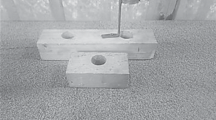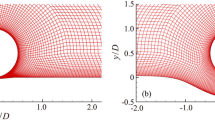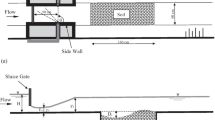Abstract
This study utilized computational fluid dynamics modeling to examine how the location, apex angle of flow deflectors and passageway percentage influenced the depth of scour across various flow conditions. Four types of deflectors were used, including two single perforated deflectors (semicircular and triangular) and two double solid deflectors semicircular and triangular. The Navier–Stokes and continuity equations were discretized using a finite volume and finite difference approach to solve fluid motions, while the RNG κ–ε turbulence model was adopted to model turbulence. The excess bed shear stress resulting from the flowing water was used to determine the bed load model, and the Volume of Fluid technique was used to model free surfaces. Results indicated that the single semicircular perforated deflector was the most effective in reducing the maximum local scour depth. This deflector reduced maximum scour depth by about 76.8%, while the double semicircular solid deflector reduced maximum scour depth by about 75.7%. The triangular perforated deflector and double triangular solid deflector reduced maximum scour depth by about 22% and 71.1%, respectively, when compared to the stilling basin without the deflector. These findings recommend that the single semicircular perforated deflector is the optimal choice for reducing maximum local scour depth.















Similar content being viewed by others
References
Ehterama M, Meymand AM (2015) Numerical modeling of scour depth at side piers of the bridge. J Comput Appl Math 280:68–79
Teraguchi H, Nakagawa H, Kawaike K, Yasuyuki B, Zhang H (2011) Effects of hydraulic structures on river morphological processes. Int J Sedim Res 26(3):283–303
M. A. Tadda, A. Ahsan, M. Imteaz, A. Shitu, U. A. Danhassan, and A. I. Muhammad, "Operation and Maintenance of Hydraulic Structures," in Hydraulic Structures-Theory and Applications: IntechOpen, 2020.
V. Hrissanthou, "Research on Hydraulics and River Dynamics," vol. 14, ed: MDPI, 2022, p. 3018.
I. Flow Science, FLOW-3D, V11.2. USA: Flow Science, Inc, 2009.
Pu JH, Lim SY (2014) Efficient numerical computation and experimental study of temporally long equilibrium scour develop ment around abutment. Environ Fluid Mech 14(1):69–86
Pu JH, Shao S, Huang Y (2014) Numerical and experimental turbulence studies on shallow open channel flows. Journal of Hydro-Environment Research 8(1):9–19
J. H. Pu, Y. Huang, S. Shao, and K. Hussain, "Three-gorges dam fine sediment pollutant transport: turbulence SPH model simu lation of multi-fluid flows," J. Appl. Fluid Mech, vol. 9, no. 1, 2016.
G. Wei, J. Brethour, M. Grünzner, and J. Burnham, "The sedimentation scour model in FLOW-3D," Flow Sci. Rep, pp. 3–14 Santa Fe, NM: Flow Science, 2014.
Duan JG, Nanda S (2006) Two-dimensional depth-averaged model simulation of suspended sediment concentration distribution in a groyne field. J Hydrol 327(3–4):426–437
Acharya A, Duan JG (2011) “Three dimensional simulation of flow field around series of spur dikes,” in World Environmental and Water Resources Congress. Bearing Knowledge for Sustainability 2011:2085–2094
Ghaderi A, Abbasi S, Abraham J, Azamathulla HM (2020) Efficiency of trapezoidal labyrinth shaped stepped spillways. Flow Meas Instrum 72:101711
Pu JH (2015) Turbulence modelling of shallow water flows using Kolmogorov approach. Comput Fluids 115:66–74
Bayon A, Valero D, García-Bartual R, López-Jiménez PA (2016) Performance assessment of OpenFOAM and FLOW-3D in the numerical modeling of a low Reynolds number hydraulic jump. Environ Model Softw 80:322–335
Ho D, Riddette K (2010) Application of computational fluid dynamics to evaluate hydraulic performance of spillways in Australia. Aust J Civ Eng 6(1):81–104
M. V. Sarfaraz and J. Attari, "Numerical Simulation of Uniform Flow Region over a Steeply Sloping Stepped Spillway," in 6th National Congress on Civil Engineering, Semnan University,Semnan, Iran, April 26–27 2011.
T. H. Nasralla, "Experimental and numerical investigation of scour downstream contracted spillways," Journal of Water and Land Development, pp. 53–59–53–59, 2022.
Ashour MA, Aly TE, Abuzaid TS (2016) A NEW EFFICIENT WATER ENERGY DISSIPATOR FOR IMPROVING THE IRRIGATION WATER QUALITY. International Water Technology Journal 6(3):195–205
K. Khalifehei, M. Sadeghi Askari, and H. Azamathulla, "Experimental investigation of energy dissipation on flip buckets with triangular deflectors," ISH Journal of Hydraulic Engineering, vol. 28, no. sup1, pp. 292–298, 2022.
Kumcu SY, Ispir K (2022) Experimental and numerical modeling of various energy dissipater designs in chute channels. Appl Water Sci 12(12):266
Z. Xie, Theoretical and numerical research on sediment transport in pressurized flow conditions. The University of Nebraska-Lincoln, 2011.
S. B. Pope, Turbulent Flows. Meas: Sci. Technol., 2001.
Dong Z, Wang J, Vetsch DF, Boes RM, Tan G (2019) Numerical simulation of air–water two-phase flow on stepped spillways behind x-shaped flaring gate piers under very high unit discharge. Water 11(10):1956
S. Li and J. Zhang, "Numerical Investigation on the Hydraulic Properties of the Skimming Flow over Pooled Stepped Spillway," Water, vol. 10, no. 1478, 2018.
W. Zhang, J. Wang, C. Zhou, Z. Dong, and Z. e. Zhou, "Numerical simulation of hydraulic characteristics in a vortex drop shaft," Water, vol. 10, no. 1393, 2018.
Yakhot V, Orszag S, Thangam S, Gatski T, Speziale C (1992) Development of turbulence models for shear flows by a double expansion technique. Phys Fluids A 4(7):1510–1520
ASTM D422–63, "Standard Test Method for Particle-Size Analysis of Soils," 2007.
Author information
Authors and Affiliations
Corresponding author
Ethics declarations
Conflict of interest
The author declare that they have no conflict of interests.
Ethical approval
This article does not contain any studies with human participants or animals performed by any of the authors.
Informed consent
For this type of study formal consent is not required.
Rights and permissions
Springer Nature or its licensor (e.g. a society or other partner) holds exclusive rights to this article under a publishing agreement with the author(s) or other rightsholder(s); author self-archiving of the accepted manuscript version of this article is solely governed by the terms of such publishing agreement and applicable law.
About this article
Cite this article
Obead, I.H., Sahib, A.R. Mathematical models for simulating the hydraulic behavior of flow deflectors: laboratory and CFD-based study. Innov. Infrastruct. Solut. 8, 213 (2023). https://doi.org/10.1007/s41062-023-01170-1
Received:
Accepted:
Published:
DOI: https://doi.org/10.1007/s41062-023-01170-1




